How Sustainable Forestry Fuels the Future of Construction: A Rayonier Perspective on Mass Timber
Published 06-04-25
Submitted by Rayonier
Originally published on Rayonier.com
Mass timber, a renewable, durable, environmentally friendly building material, is changing the building industry for the better. In this article, we take a deeper look at the environmental, economic and human benefits of mass timber and highlight some mass timber success stories.
For decades, most city skylines have been composed of skyscrapers and tall buildings made of concrete, steel and glass.
But what if there were a building material that was strong enough to construct an 18-story building, came from entirely renewable resources, didn’t make cities hotter and helped sequester carbon and other pollutants?
Meet mass timber, the durable, beautiful, fire-resistant and environmentally-friendly building material that is changing the face of skylines. This wood-based building material has a considerably lower carbon footprint, generating fewer carbon emissions during and after construction.
In fact, one study found a 19 percent reduction in emissions when comparing a mass timber structure with an equally sized steel structure.1 Mass timber also comes from a renewable, naturally-growing resource: trees.
In this guide, we’re looking at the benefits of mass timber and how it is reshaping the commercial building industry. We’re also taking a close look at the story of 619 Ponce, an entirely locally-sourced mass timber structure championed in part by the Georgia Forestry Foundation in the heart of Atlanta.
- What is Mass Timber (and why is it important)?
- Types of Mass Timber Products
- Why are Mass Timber Buildings Gaining Popularity?
- What Type of Trees is Mass Timber Made From?
- What are the Benefits of Mass Timber?
- Examples of Mass Timber Buildings
- 619 Ponce Mass Timber Building Success Story
- Rayonier’s Role in the Mass Timber Revolution
What is Mass Timber (and why is it important)?
Mass timber is made from prefabricated, multilayered, solid wood panels that create solid timber building materials, such as:
- Beams and columns,
- Floor, roof and wall panels,
- Tall wall framing studs and roof rafters,
- Door and window headers, and more.

Types of Mass Timber Products
Mass timber products, like those made with Rayonier timber, come from renewable and sustainably-harvested wood products. Types of mass timber products include:
- Cross-laminated timber (CLT): Layers of wood stacked and glued at right angles, creating strong, stable panels ideal for walls, floors and roofs.
- Glue-laminated timber (glulam): Long beams made from layers of wood bonded together, often used for load-bearing columns and arches. It can be curved or bent for unique architectural designs during its construction.
- Nail-laminated timber (NLT): Panels made by nailing or screwing layers of wood together, a cost-effective choice for floors, walls and roofs. This material also can be customized for a variety of textured appearances and unique forms.
- Structural composite lumber (SCL): Engineered wood made from wood strands or veneers, using a moisture-resistant adhesive. SCL can come in panels as much as 8 feet wide and is designed for use in beams, headers, columns and other structural components.
Why are Mass Timber Buildings Gaining Popularity?
Using mass timber is a tremendous win for builders, architects, designers, consumers and environmentally-responsible cities seeking healthier and more eco-functional building materials to benefit their cities and citizens.
Until recently, mass timber was used only in residential homes and smaller buildings no larger than six stories or 85 feet. This was due in large part to outdated building codes, which were established with more traditional lumber materials in mind.
However, in light of the specific qualities that make mass timber different, such as its fire resistance and sturdiness even against natural disasters, changes to International Building Codes in 2021 deemed it safe to use mass timber in buildings up to 18 stories high.
What Type of Trees Is Mass Timber Made From?
Common species used in mass timber include Douglas fir, pine, and spruce—all of which are known for their strength and renewability.
One of the biggest misconceptions about modern timber materials is that they are sourced from forests in a way that will deplete timber resources.
Today, the majority of timber products are sourced from sustainably managed forests grown for the purposes of harvesting.
These forests are then replanted, beginning the process of growing timber all over again.
What are the Benefits of Mass Timber?
Mass timber offers specific benefits across three main areas: the environment, the economy, and human well-being.
Environmental Benefits of Mass Timber
When you compare the impacts of building with sustainably grown trees to traditional building materials, like steel and concrete, the environmental benefits are significant. For instance:
- Renewable resource: Trees used to manufacture mass timber products are grown in sustainably managed forests and replanted after harvest, making mass timber an entirely renewable resource.
- Minimized waste: Sawmill residues are typically used in mass timber manufacturing, helping reduce waste associated with production.
- Reduced resource extraction: Unlike concrete and steel, mass timber does not require mined materials or fossil fuels.
- Biodegradable and repurposable: Mass timber is biodegradable or, in some cases, can be repurposed—like barn wood.
- Water efficiency: Mass timber production uses far less water than concrete and steel.
- Carbon storage: Studies have also shown mass timber can help store carbon and other pollutants for the life of the building.2
For example: A 2024 study showed mass timber materials have the potential to store between 9.9 and 16.5 million tons of CO2 per-year, spanning 50 years, from 2020 to 2070. These carbon benefits equate to 12-20% of the total U.S. harvested wood products carbon storage for 2020.3 - Long-Term Carbon Impact: Experts and advocates have even suggested mass timber can help the North American construction industry store more carbon than it emits by 2034.4
All of these characteristics contribute to making mass timber a low-carbon material compared to concrete and steel.
Economic Benefits of Mass Timber
Research has shown building with mass timber has economic benefits for builders and construction companies, including:
- Faster Construction Time: Mass timber construction can be faster than traditional methods.
For example: According to reports from builders of mass timber structures, such as the Ascent, a 25-story mass timber hybrid building in Milwaukee, mass timber can speed construction time by 20-30%.5 Studies have also shown mass timber shortens construction time.6 - Improved Project Efficiency: The use of prefabricated mass timber products requires less on-site assembly, streamlining the construction process and enhancing overall project efficiency.
- Increased Safety: In addition to improved building time, project safety is improved due to the prefabrication of the materials, which requires less on-site construction in high or precarious places.
- Reduced Labor Needs: Using mass timber requires half the amount of workers, saving companies and their clients money.
- Cost-Competitive with Traditional Materials: Mass timber is often cost-competitive with conventional materials, as outlined in a case study by the University of British Columbia.7
- Job Creation in Diverse Communities: The growing, harvesting, processing and manufacturing of mass timber products also creates substantial job opportunities in rural and urban communities for people with various skill sets.
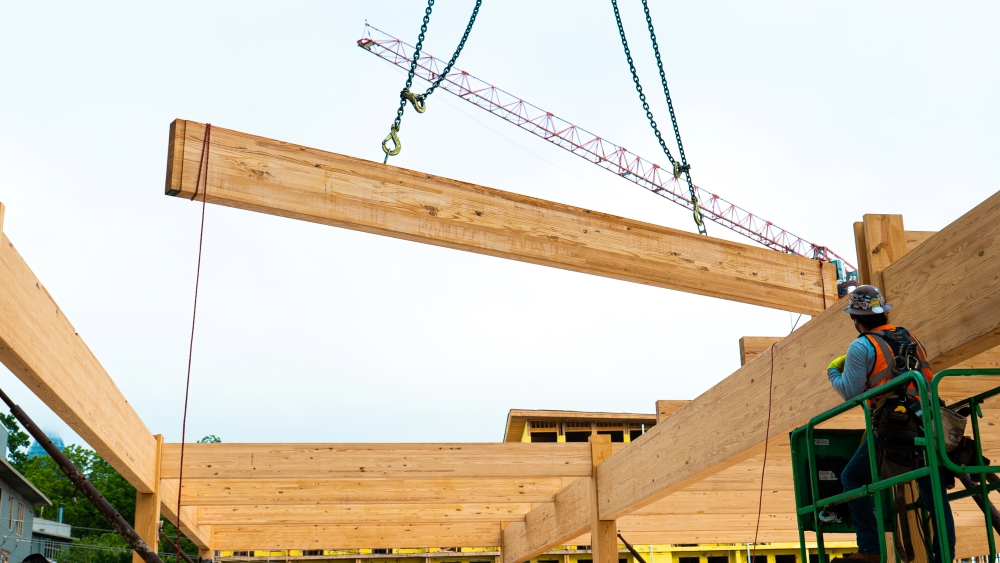
Human Benefits of Mass Timber:
Mass timber has numerous benefits to human health and well-being, including:
- Improved Air Quality: Mass timber is one of the only commercial building materials shown to store carbon while not creating extra heat, unlike concrete or steel buildings.
- Noise Reduction and Tranquility: Research from the University of British Columbia in 2016 showed mass timber buildings provide excellent sound insulation and absorption properties8, promoting a peaceful indoor environment.
- Excellent Fire Resistance: Mass timber’s natural fire resistance makes it a safer building material for homes and offices. When ignited, the outer layers form a char layer, which protects and insulates the inner layers of the material.
- Overall Health and Wellness Benefits: Ample research has shown exposure to nature and the natural elements, including natural building materials, supports various aspects of health, including: cognitive function, blood pressure, stress response, immune function, faster recovery and healing, and psychological well-being. 9101112
Bottom line: research has shown mass timber benefits the planet, its people and its economies.
Examples of Mass Timber Buildings
Mass timber buildings, also known as Tall Wood Buildings, are still dwarfed by their steel and concrete predecessors.
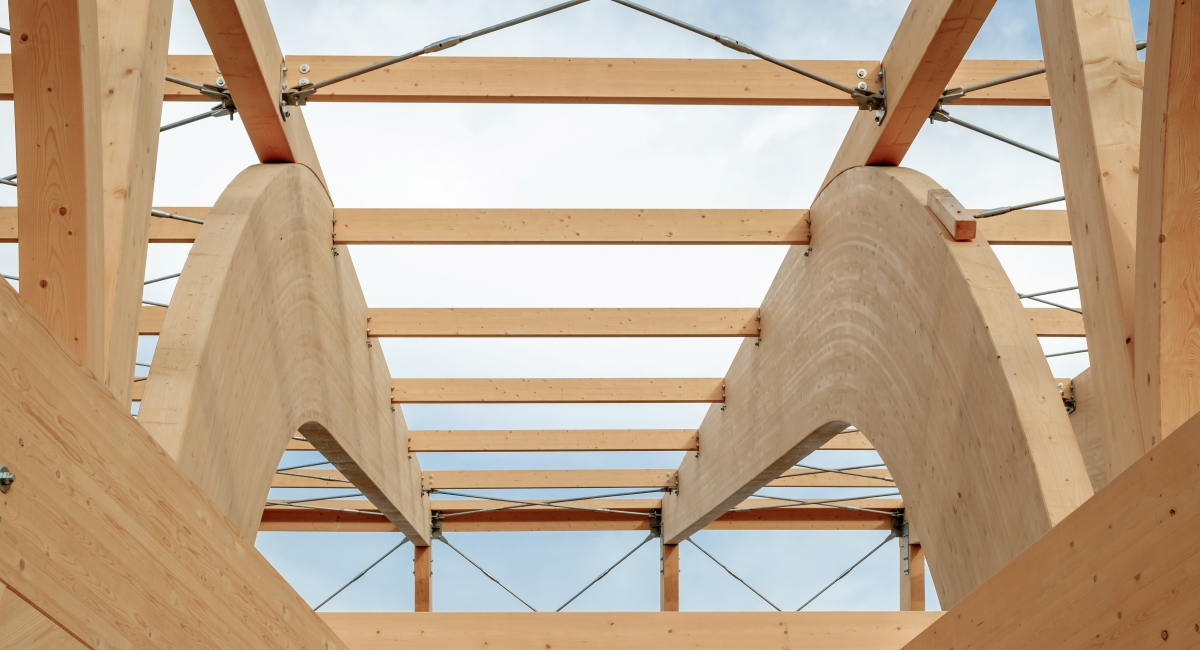
However, several cities worldwide have been early adopters of this type of construction. Some North American examples include:
- Carbon 12 building in Portland, Oregon: This eight-story mass timber building includes residences on the upper floors as well as commercial space on the ground floor. Architects Kaiser + Path worked with local and state officials to waive building codes limiting the height of wood buildings. Learn more about how it was built at kaiserpath.com/carbon12.
- The Brock Commons at the University of British Columbia in Vancouver, British Columbia, Canada. This 18-story dormitory residential building is the largest mass timber building in the world to date.

- The Ascent: A 25-story, 285-foot mass timber hybrid building in Milwaukee featuring luxury rentals, the Ascent became the tallest hybrid mass timber building in the world when construction was completed in 2022.
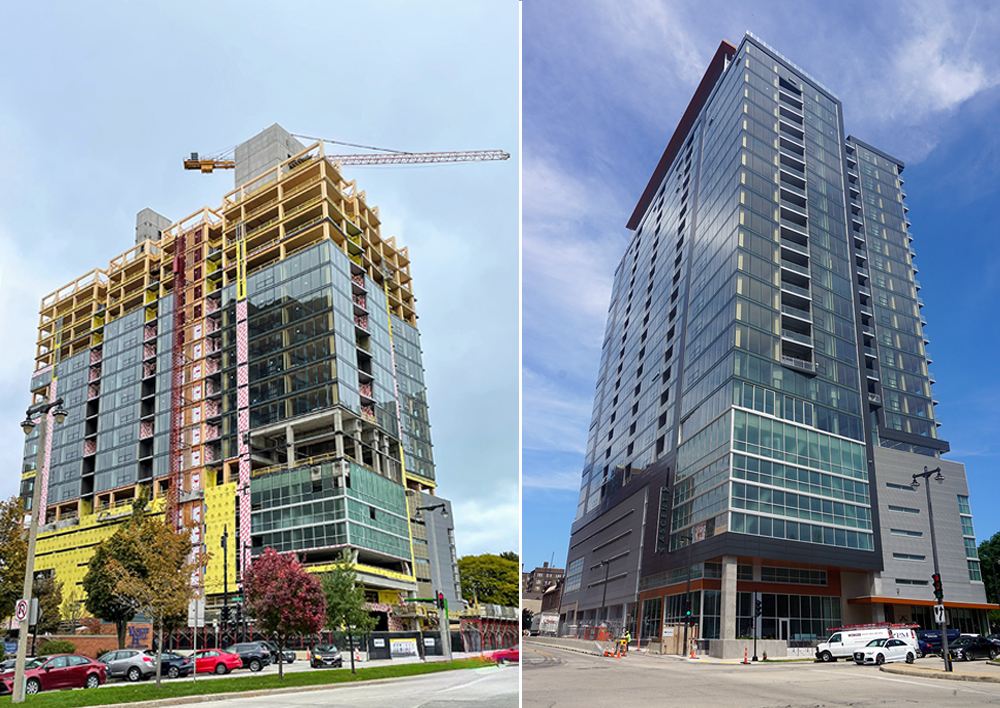
- The Kendeda Building of Sustainable and Innovative Design at Georgia Tech in Atlanta: The first building in Georgia and 28th in the world to earn Living Building Challenge (LBC) certification, the world’s most ambitious and holistic green building achievement. Used for education, research and outreach, among the building’s accolades are zero carbon construction, net positive energy and net positive water, thanks to a design that incorporates mass timber, a solar canopy and rain capture.
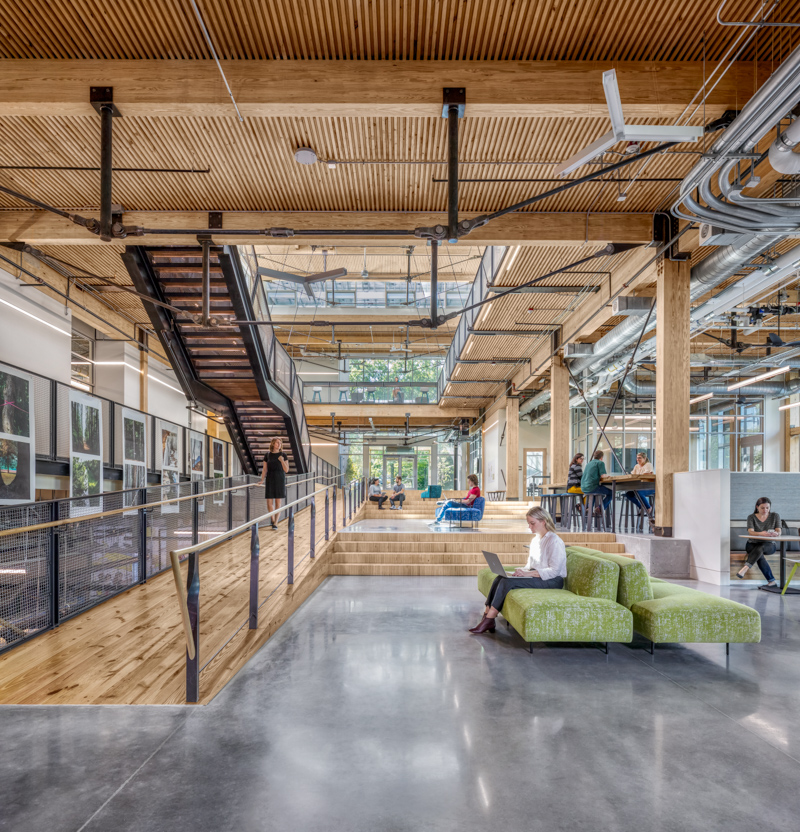
- The High Line Timber Bridge in New York City: This 260-foot-long bridge is set amidst a lush garden-like landscape in the heart of Manhattan, allowing pedestrians to travel above busy streets.
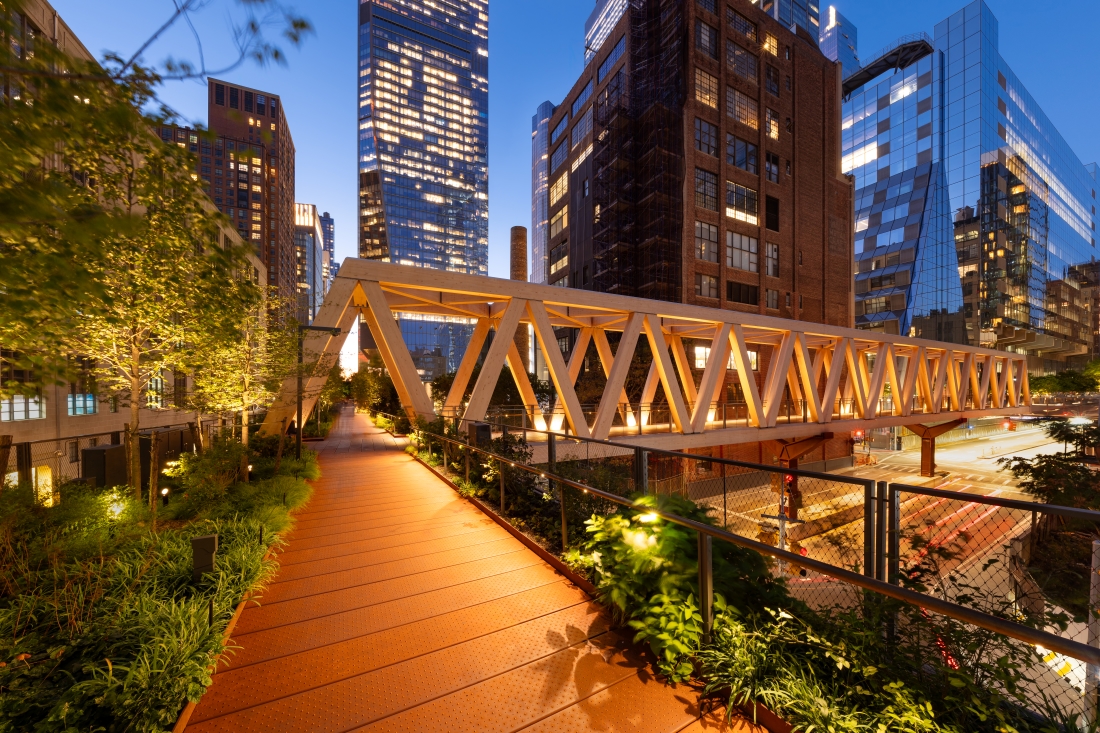
- The Theodore Roosevelt Presidential Library: The design of this 93,000-square-foot library in Medora, North Dakota, was inspired by Roosevelt’s personal reflections on the landscape, his interest in environmental stewardship and periods of quiet introspection and civic engagement in his life.
- 619 Ponce: Located in Atlanta next to the popular Ponce City Market, this office and retail space is Georgia’s first building constructed using locally-sourced mass timber.
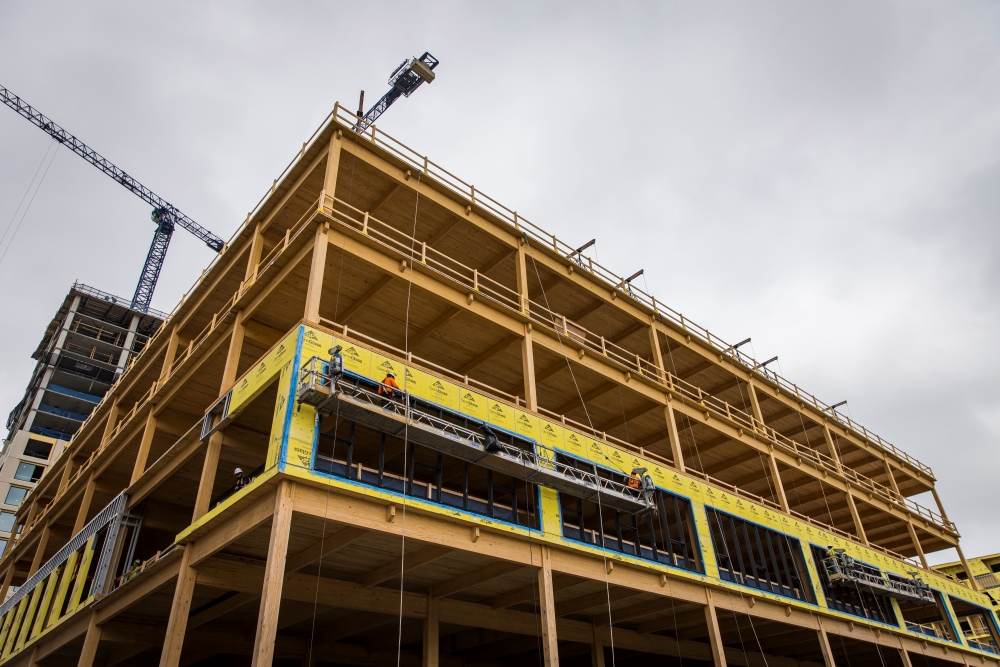
Supporting Atlanta’s 619 Ponce: A Mass Timber Building Success Story
For an insider’s perspective, we talked to Matt Hestad, Vice President of the Georgia Forestry Foundation (Foundation), about their participation in spearheading the mass timber building, 619 Ponce in Atlanta. Matt noted that the Foundation’s focus on mass timber not only served to support Georgia’s working forests by promoting new markets for locally grown sustainable wood products, but it has also built an important thought bridge between people living in urban Atlanta and the rural parts of Georgia, where sustainable forestry happens every day.
“We can’t underestimate the importance of everyday Georgians knowing where the wood products that they depend on every day come from and the trust that is built from knowing that it is sustainably produced and sourced,” he says.
Georgia’s Forestry Leadership in Mass Timber Production
It is commonly presumed that tree-adorned Washington State or Oregon are the country’s largest source of timber.
However, as Matt told us, Georgia is the #1 forestry state in the nation, with 22 million acres of commercially available private timberland.13 Georgia also leads the country in annual timber harvest volume, forest product exports and seedling production for reforestation.
But the Foundation hasn’t been alone in its quest to support mass timber development. Since 2017, through the work of its parent organization, the Georgia Forestry Association (GFA), several pieces of legislation have been passed by Georgia’s Legislature to advance opportunities for mass timber construction in the state.
These include stopping a ban on the use of lumber in buildings over 3 stories, adopting international building codes that allow construction with mass timber up to 18 stories, and creating a sustainable development carbon registry that allows builders to register and monetize the carbon stored in mass timber buildings.
Anticipating the impact mass timber could have on community sustainability
“As the top forestry state, we have an abundant supply of available timber that can be locally sourced for mass timber construction projects,” Matt says.
“Mass timber can play a significant role in the sustainability of our communities because more than 40 percent of the world’s emissions come from the built environment. When you think about the fact we can replace carbon-emitting materials like steel and concrete with mass timber where, as trees grow in a forest, it’s sequestering carbon and releasing oxygen,” he says. “It’s also holding carbon as 50% of the dry wood, so that’s locked up in the building materials. We have a huge opportunity to start shifting the emissions portfolio of our communities from a really carbon-intensive process to one where we’re storing carbon.”
Benefits for Timberland Owners and Local Economies
GFF also sees mass timber benefiting private timberland owners and local economies:
“From a markets perspective, we understand that forestry and land management investments follow the demand for forest products,” Matt explains.
“If society values the products that come from working forests, it will value the land as a real estate asset. If the land is valuable, landowners will be incentivized to continue using their own dollars to invest in forest management and reforestation.”
Making timberland investments even more valuable
“Mass timber layers on another value proposition for society, and therefore is an opportunity to further incentivize those forest landowners, which makes their timberland even more valuable,” Matt says.
A New Market for Mass Timber Beyond Single-Family Homes
In addition, GFA sees mass timber as a solution to the lack of demand for new construction single-family homes, which has plagued the forestry market since the housing collapse in 2008.
“The forestry sector has traditionally relied on single-family homes to drive the need for lumber. Since 2008, that market has been lagging,” Matt says. “I think mass timber shows a lot of promise in introducing a new market for forest products in which we have the opportunity to increase demand for mass timber as a primary structural material for multi-family and mixed-use developments.”
Expanding Mass Timber’s Role in Mid-Rise Buildings
Many experts believe that the most significant opportunity lies in mid-rise (Type IV) buildings. These traditionally four- or five-story buildings are ideal uses for mass timber, as they replace the need for concrete and steel and can be built faster and more efficiently.
One such example is the aforementioned 619 Ponce, a showcase mass timber building developed by Jamestown LP next door to the iconic Ponce City Market in Atlanta. The Georgia Forestry Foundation launched its Seedlings to Solutions Initiative to tell the story of mass timber and the benefits of sourcing it locally. One feature of the project includes the Torus Arch, a mass timber education feature.
“On this project, Jamestown was told the best, most cost-effective way to obtain the mass timber was to import it from Austria because the market is much more mature in that part of the world.
“Right now, the only mass timber facility in the U.S. South is in Dothan, Alabama. So, unfortunately, it is more expensive, in some cases, to source mass timber locally, but that’s changing,” Matt explains. “We hope that, with people like Jamestown investing in mass timber, it will bring more mass timber manufacturing to the U.S. South, and developers will be able to greater realize the cost savings with faster construction time and less labor.”
The project went forward using mass timber sourced locally from West Georgia on Jamestown-owned land.
Per a U.S. Forestry Service Forest Inventory Analysis, Georgia grows enough wood to supply a mass timber building of the scale of 619 Ponce every 16 minutes.14
Andres Villegas, Vice President of Public Affairs and Communications at Rayonier, has been on the Georgia Forestry Foundation Board since 2015 and currently serves as the Vice Chairman. He recounts his experience watching the construction of 619 Ponce in comparison to a traditional concrete and steel building happening simultaneously:
“It was surprising to see an entire building go up quickly with only 8-10 workers and a crane on the worksite. Mass timber has clear advantages in terms of the speed, efficiency and beauty compared to traditional construction projects that is measurable from a profit and loss perspective. That is important because the buildings not only have to be appealing to consumers, they also have to be competitive for the developer to build.”
Far-reaching aesthetic and environmental benefits
“Today, 619 Ponce is a beautiful, warm and inviting space,” Andres says.
“It’s interesting to see, when you take people on tours, they automatically want to hug one of the mass timber beams! You can’t deny the biophilic benefits of being in this natural environment, and developers tend to do a good job making sure there’s plenty of sunlight. It is a key differentiator of the space. It feels different.”
“At the end of the day, that allows investors to realize an appreciation in their rent,” he says. “They can charge a little bit more to folks leasing these spaces because they know that their tenants are looking for a sustainable option that gives them a competitive edge with recruiting great talent and retaining great customers.”
Exploring Carbon Credits with Mass Timber
Matt also mentioned the benefits of mass timber for acquiring and selling carbon credits.
“In 2022, we asked ourselves: ‘What if we supported developers for investing in a building material that reduces carbon emissions rather than emitting them?’ GFA worked with elected officials to pass a bill that expanded Georgia’s existing carbon registry to consider the embodied and embedded carbon in materials—like mass timber. It’s really a first-of-its-kind registry, where developers—if they choose to list their embodied and embedded carbon—can get it third-party verified and listed.
“We’re hoping 619 Ponce will be the first one listed on that registry. Once the carbon is listed, the owners can do whatever they want to with it. For example, they can monetize it and turn it into carbon credits they’d sell to someone trying to offset their emissions.”
Matt acknowledges it’s a long-term play, but projects like 619 Ponce serve as a critical learning environment and a prime example of what’s possible with mass timber sourced within a 600-mile range.
Click here to learn more about GFA’s mass timber projects and initiatives.
Rayonier’s Role in the Mass Timber Revolution
Rayonier has been an early adopter and thus has a long history of environmental responsibility and stewardship in forestry.
We practice a land stewardship ethic that integrates reforestation, managing, growing, nurturing and harvesting trees as an economic enterprise with the conservation of natural resources and energy, wildlife and fish habitats and aesthetics.
To date, our working forests sequestered 13 million metric tonnes of carbon in 2023, removing approximately seven times more carbon than our efforts emitted. That’s the equivalent of removing over 3 million cars from the road.

Our commitment to environmental stewardship goes hand in hand with our passion for producing raw materials for environmentally friendly building products from our SFI-certified, sustainably managed forests, such as mass timber.
Wood products have always been used to create beautiful, functional and sustainable structures—long before concrete and steel came along.
We see mass timber as the next generation in sustainable wood construction, and we will continue investing in these innovations through forestry programs and sustainability programs, as well as our continued collaboration with organizations who champion working forests and the sustainable wood products that come from them.
Forests have always provided incredible inspiration and resources for humanity, and we see mass timber as an integral part of shaping a brighter and healthier future.
1. Hemmati, Messadi, Gu, Seddelmeyer and Hemmati. (April 2024.) “Comparison of Embodied Carbon Footprint of a Mass Timber Building Structure with a Steel Equivalent.” MDPI.https://www.mdpi.com/2075-5309/14/5/1276
2. “Review of the Performance and Benefits of Mass Timber as an Alternative to Concrete and Steel for Improving the Sustainability of Structures”. Sustainability
3. Nepal, P., Prestemon, J. P., Ganguly, I., Kumar, V., Bergman, R. D., & Poudyal, N. C. (2024). “The potential use of mass timber in mid-to high-rise construction and the associated carbon benefits in the United States”. PLOS ONE, 19(3), e0298379. https://doi.org/10.1371/journal.pone.0298379
4. “2024 Mass Timber International Report”. https://masstimberconference.com/report/
5. “Mass Timber”. American Wood Council.
6. “Review of the Performance and Benefits of Mass Timber as an Alternative to Concrete and Steel for Improving the Sustainability of Structures”. Sustainability.
7. Case Study: An 18-storey tall mass timber hybrid student residence at the University of British ColumbiaStudent residence Brock Commons Vancouver (18 story hybrid building). https://events.forum-holzbau.com/pdf/37_IHF_2016_Fast.pdf
8. Eighteen Storey Hybrid Mass Timber Student Residence at the University of British Columbia. Journal of Structural Engineering International. DOI: 10.2749/101686617X14676303588553
9. Interior wood use in classrooms reduces pupils’ stress levels. Conference: 9th Biennial Conference on Environmental Psychology At: Eindhoven, The Netherlands.
10. Appearance wood products and psychological well-being. January 2007. Wood and Fiber Science.
11. View through a window may influence recovery from surgery. Science. 1984 Apr 27;224(4647):420-1. doi: 10.1126/science.6143402. PMID: 6143402.
12. Zhong, W., Schröder, T., & Bekkering, J. (2022). Biophilic design in architecture and its contributions to health, well-being, and sustainability: A critical review. Frontiers of Architectural Research, 11(1), 114-141. https://doi.org/10.1016/j.foar.2021.07.006
13. Georgia Forestry Commission. (2011). Georgia Forest Facts. Web; accessed: March 2020.
14. Based on U.S. Forest Service Forest Inventory Analysis Data: Georgia timberlands took 989.8 seconds to grow the 1,845 cubic meters of wood.
This article was published on December 16, 2024

Rayonier
Rayonier
Rayonier (NYSE:RYN) is a leading timberland real estate investment trust with assets located in some of the most productive softwood timber growing regions in the United States and New Zealand. We own or lease under long-term agreements approximately 2.8 million acres of timberlands located in the U.S. South, U.S. Pacific Northwest and New Zealand. We are More than trees because we recognize that our 90+ years of success in the timberland industry comes from our people, an empowering culture and the courage to constantly challenge “the way it’s always been done.” Get to know us at www.rayonier.com.
More from Rayonier

